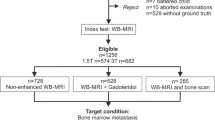Abstract
Purpose: To evaluate the usefulness of whole-body (WB) MRI for detecting metastases from paediatric malignant tumours in comparison with conventional oncological imaging methods. Materials and methods: Using a 1.5-T system, a coronal short tau inversion recovery (STIR) sequence was obtained in all patients. In addition, sagittal fat-suppressed T2-weighted, sagittal STIR, or coronal fat-suppressed pre-contrast and post-contrast T1-weighted sequences were performed. Patients who underwent WB MRI and conventional oncological imaging within 15 days were enrolled in the study. In total, 58 bone scintigraphies, 26 iodine-123 (123I) meta-iodo-benzylguanidine (MIBG) scintigraphies, and 48 CT scans were available for comparison in 36 patients (median age 3.5 years; 21 boys, 15 girls) who underwent 82 WB MRI examinations. Skeletal and extraskeletal metastases were evaluated for a variety of tumour types. Results: Concordance rate of WB MRI between two readers was 74%. In detecting metastases, WB MRI had higher sensitivity (99%) and PPV (94%) than bone scintigraphy (26 and 76%, respectively). In detecting skeletal metastases, WB MRI revealed higher sensitivity (100%) than 123I-MIBG scintigraphy (25%) and CT (10%). In contrast, WB MRI showed lower PPV in detecting skeletal and extraskeletal metastases (8 and 57%, respectively) than 123I-MIBG scintigraphy (100%), and lower sensitivity (60%) in detecting extraskeletal metastases than CT (100%). In 2 of 11 untreated patients, tumour staging was upgraded from stage 3 to 4 according to WB MRI findings. In 3 patients, WB MRI revealed early treatment responses (<1 year) of skeletal metastases. Conclusions: WB MRI can substitute for bone scintigraphy in detecting skeletal metastases of paediatric malignant tumours, and it is useful in evaluating initial tumour staging and early treatment responses. However, it still has only a complementary role in detecting extraskeletal metastases.





Similar content being viewed by others
References
Lauenstein TC, Freundenberg LS, Goehde SC, et al (2002) Whole-body MRI using a rolling table platform for the detection of bone metastases. Eur Radiol 12:2091–2099
Eustace S, Tello R, Yucel EK (1998) Whole-body turbo STIR MR imaging in unknown primary tumor detection. J Magn Reson Imaging 8:751–753
Eustace S, Walker RE, Blake M, et al (1999) Whole-body MR imaging. Practical issues, clinical applications, and future directions. Magn Reson Clin North Am 9:209–235
Walker R, Harper K, Eustace S (2000) Whole-body turbo STIR MR imaging in breast carcinoma: preliminary clinical experience. J Magn Reson Imaging 11:343–350
Lauenstein TC, Goehde SC, Herborn CU, et al (2002) Three-dimensional volumetric interpolated breath hold MR imaging for whole-body tumor staging in less than 15 min: a feasibility study. AJR 179:445–449
Engelhard K, Hollenbach HP, Wohlfart K, et al (2004) Comparison of whole-body MRI with automatic moving table technique and bone scintigraphy for screening for bone metastases in patients with breast cancer. Eur Radiol 14:99–105
Hargaden G, O’Connell M, Kavanagh E, et al (2003) Current concepts in whole-body imaging using turbo short tau inversion recovery MR imaging. AJR 180:247–252
Iizuka-Mikami M, Nagai K, Yoshida K, et al (2004) Detection of bone marrow and extramedullary involvement in patients with non-Hodgkin’s lymphoma by whole-body MRI: comparison with bone and 67Ga scintigraphies. Eur Radiol 14:1074–1081
Lauenstein TC, Goehde SC, Herborn CU, et al (2004) Whole-body MR imaging: evaluation of patients for metastases. Radiology 233:139–148
Daldrup-Link HE, Franzius C, Link TM, et al (2001) Whole-body MR imaging for detection of bone metastases in children and young adults: comparison with skeletal scintigraphy and FDG PET. AJR 177:229–236
Kellenberger CJ, Epelman M, Miller SF, et al (2004) Fast STIR whole-body MR imaging in children. Radiographics 24:1317–1330
Kellenberger CJ, Miller SF, Khan M, et al (2004) Initial experience with FSE STIR whole-body MR imaging for staging lymphoma in children. Eur Radiol 14:1829–1841
Mazumdar A, Siegel MJ, Narra V, et al (2002) Whole-body fast inversion recovery MR imaging of small cell neoplasms in pediatric patients: a pilot study. AJR 179:1261–1266
Laffan EE, O’Connor R, Ryan SP, et al (2004) Whole-body magnetic resonance imaging: a useful additional sequence in paediatric imaging. Pediatr Radiol 34:472–480
Mentzel HJ, Kentouche K, Sauner D, et al (2004) Comparison of whole-body STIR-MRI and 99mTc-methylene-diphosphonate scintigraphy in children with suspected multifocal bone lesions. Eur Radiol 14:2297–2302
Pfluger T, Schmied C, Porn U, et al (2003) Integrated imaging using MRI and 123I metaiodobenzylguanidine scintigraphy to improve sensitivity and specificity in the diagnosis of pediatric neuroblastoma. AJR 181:1115–1124
Dosdá R, Martí-Bonmatí L, Ronchera-Oms CL, et al (2003) Effect of subcutaneous butylscopolamine administration in the reduction of peristaltic artifacts in 1.5-T MR fast abdominal examinations. Eur Radiol 13:294–298
Brenner DJ, Elliston CD (2004) Estimated radiation risks potentially associated with full-body CT screening. Radiology 232:735–738
Author information
Authors and Affiliations
Corresponding author
Rights and permissions
About this article
Cite this article
Goo, H.W., Choi, S.H., Ghim, T. et al. Whole-body MRI of paediatric malignant tumours: comparison with conventional oncological imaging methods. Pediatr Radiol 35, 766–773 (2005). https://doi.org/10.1007/s00247-005-1459-x
Received:
Revised:
Accepted:
Published:
Issue Date:
DOI: https://doi.org/10.1007/s00247-005-1459-x




